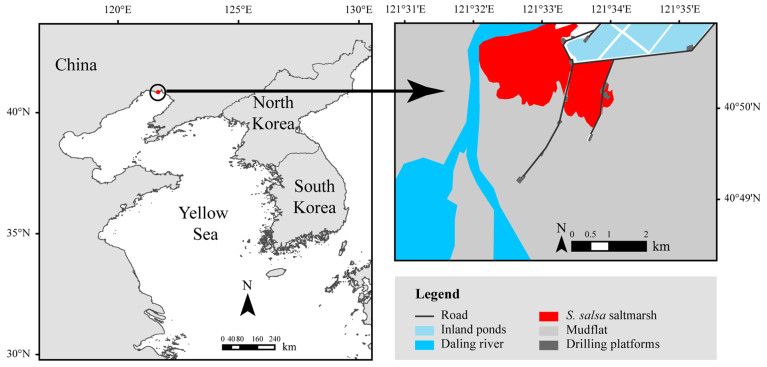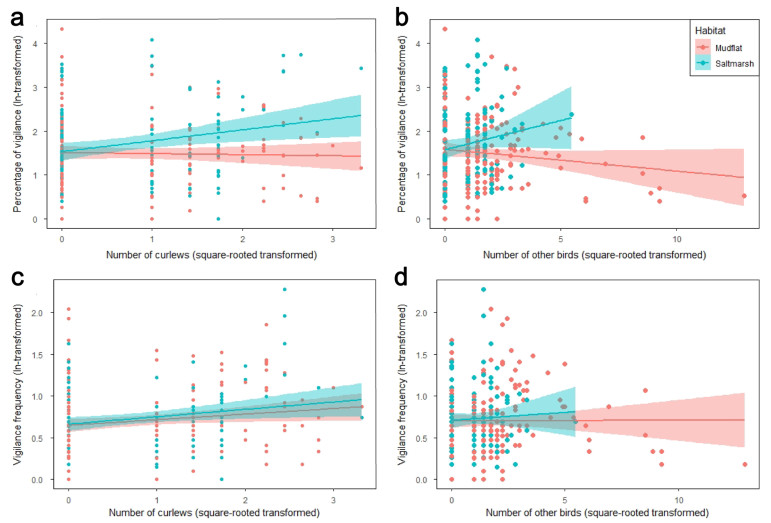
Difference in the percentage time spent under visual obstruction ± SE between Far Eastern Curlew (a) and Eurasian Curlew (b) in two different coastal habitats (S. salsa saltmarsh vs. mudflat) and seasons (spring vs. autumn)
Figures of the Article
-
![]() Location of the study site on the northern region of the Yellow Sea, eastern coastal China
Location of the study site on the northern region of the Yellow Sea, eastern coastal China
-
![]() Difference in the percentage time spent under visual obstruction ± SE between Far Eastern Curlew (a) and Eurasian Curlew (b) in two different coastal habitats (S. salsa saltmarsh vs. mudflat) and seasons (spring vs. autumn)
Difference in the percentage time spent under visual obstruction ± SE between Far Eastern Curlew (a) and Eurasian Curlew (b) in two different coastal habitats (S. salsa saltmarsh vs. mudflat) and seasons (spring vs. autumn)
-
![]() Estimated marginal means (EMMs) ± SE for the linear mixed models for vigilance behaviour of Far Eastern Curlew (FEC) and Eurasian Curlew (EC). Data shown were ln-translated percentage of vigilance time (%) and vigilance frequency (/min). Post-hoc Tukey t-test were compared separately for each curlew species between habitat types, human disturbance and migration seasons. *** < 0.001; ** < 0.01; * < 0.05
Estimated marginal means (EMMs) ± SE for the linear mixed models for vigilance behaviour of Far Eastern Curlew (FEC) and Eurasian Curlew (EC). Data shown were ln-translated percentage of vigilance time (%) and vigilance frequency (/min). Post-hoc Tukey t-test were compared separately for each curlew species between habitat types, human disturbance and migration seasons. *** < 0.001; ** < 0.01; * < 0.05
-
![]() Habitat-dependent variation in flock size (conspecific and heterospecific) and curlew vigilance behaviour (percentage of vigilance time, % and vigilance frequency/min) in S. salsa saltmarsh and adjacent mudflat
Habitat-dependent variation in flock size (conspecific and heterospecific) and curlew vigilance behaviour (percentage of vigilance time, % and vigilance frequency/min) in S. salsa saltmarsh and adjacent mudflat
Related articles
-
2025, 16(1): 100259. DOI: 10.1016/j.avrs.2025.100259
-
2024, 15(1): 100157. DOI: 10.1016/j.avrs.2023.100157
-
2022, 13(1): 100068. DOI: 10.1016/j.avrs.2022.100068
-
2021, 12(1): 38. DOI: 10.1186/s40657-021-00272-7
-
2021, 12(1): 36. DOI: 10.1186/s40657-021-00271-8
-
2020, 11(1): 41. DOI: 10.1186/s40657-020-00228-3
-
2020, 11(1): 24. DOI: 10.1186/s40657-020-00210-z
-
2018, 9(1): 44. DOI: 10.1186/s40657-018-0137-2
-
2017, 8(1): 20. DOI: 10.1186/s40657-017-0078-1
-
2011, 2(3): 147-151. DOI: 10.5122/cbirds.2011.0020


 Download:
Download:








 Email Alerts
Email Alerts RSS Feeds
RSS Feeds